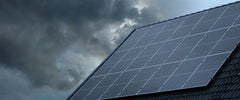
Do Solar Panels Work on Cloudy Days or at Night?
, 5 min reading time


, 5 min reading time
Solar panels have revolutionized renewable energy, but a critical question remains: Can they generate electricity without direct sunlight? The short answer: Yes on cloudy days, but not at night. However, the full picture involves efficiency, energy storage, and technology. Let's dive into how solar panels perform under clouds and after sunset—and how to maximize their benefits.
Solar panels convert sunlight into electricity through photovoltaic (PV) cells, typically made of silicon. Here's a simplified process:
1. Sunlight Absorption - PV cells absorb photons (light particles).
2. Electron Excitation - Energy knocks electrons loose, creating an electric current.
3. Electricity Conversion - An inverter transforms direct current (DC) into alternating current (AC) for household use.
Key Takeaway: Solar panels rely on light, not heat, allowing them to function even on cooler or overcast days.
Shop High Efficiency Solar Panels
Reduced Efficiency - Solar panels generate electricity best under direct sunlight but still work when it's cloudy. Clouds scatter sunlight, allowing some diffused light to reach the panels, reducing efficiency.
Energy Production - The amount of energy produced on cloudy days depends on the density of cloud cover and the type of solar panels used. On average:
|
Cloud Cover |
Efficiency Reduction |
|
Light clouds |
10-25% decrease |
|
Moderate clouds |
25-50% decrease |
|
Heavy clouds |
50%+ decrease |
Solutions for Cloudy Regions
No Sunlight, No Power - Solar panels require sunlight to generate electricity, so production stops entirely at night.
Energy Storage Solutions - To maintain a steady power supply at night, solar users integrate battery storage systems. These batteries store excess daytime energy for use after dark.
|
Storage Solution |
Pros |
Cons |
|
Lithium-ion batteries |
High efficiency, long lifespan |
Higher upfront cost |
|
Lead-acid batteries |
More affordable |
Lower lifespan, bulkier |
|
Grid-tied net metering |
Offset nighttime grid usage |
Relies on grid stability |
Pro Tip: Pairing solar panels with batteries enhances energy independence and reduces grid reliance.
A. Location & Weather
B. Panel Technology
|
Panel Type |
Low-Light Efficiency |
Cost |
Best For |
|
Monocrystalline |
High |
Expensive |
Sunny regions |
|
Polycrystalline |
Moderate |
Mid-range |
Budget-conscious buyers |
|
Thin-film |
Low to moderate |
Affordable
|
Cloudy climates, large spaces |
C. Seasonal & Daily Variations
Optimization Tip: Adjust panel tilt seasonally and ensure south-facing orientation (Northern Hemisphere).
Solar panels work on cloudy days (with reduced output) and rely on storage or the grid at night. By combining panels with batteries or net metering, you can achieve 24/7 energy reliability.
Next Steps:
Whether you live in sunny California or cloudy Seattle, solar energy remains a sustainable, cost-effective solution. Start your solar journey today!
A: Yes, but efficiency drops. Rain can also help clean panels, improving post-storm performance.
A: Only with a battery backup. Grid-tied systems shut off for safety.
A: Typically 8–12 hours for essentials like lights and refrigeration.
A: Yes, but prioritize high-efficiency panels and storage systems.
A: Tilt angle ≈ your latitude. Face south (Northern Hemisphere) for optimal exposure.
A: Yes, but snow and shorter days reduce output. Regular cleaning helps!



